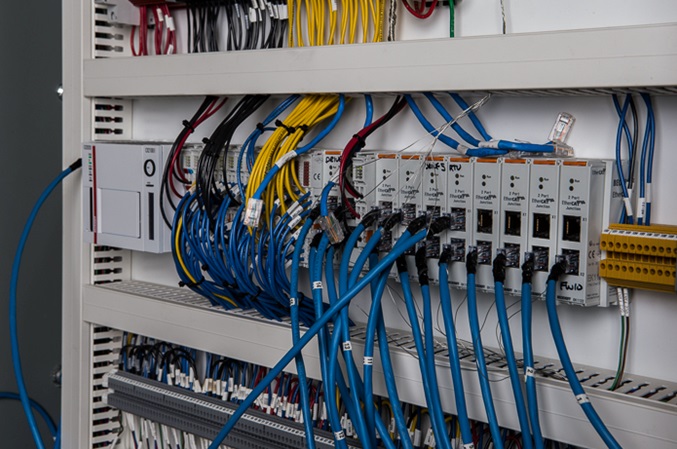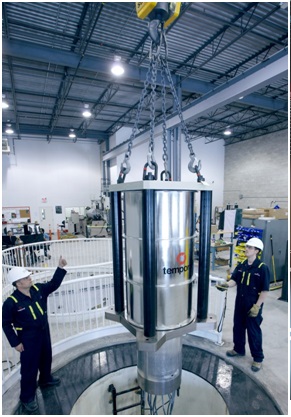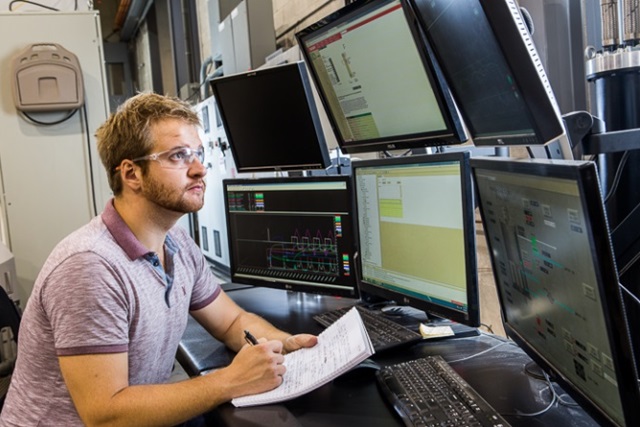Temporal Power puts a new spin on renewable-energy storage
Josh Olson / Beckhoff Automation / www.beckhoff.com/wind
Spinning at over 12,000 rpm, this flywheel-based power storage provides a new development for grid regulation in alternative-energy applications
Flywheels have been around for generations, but few have seen use in modern-day power installations. However, Temporal Power, based in Mississauga, Ontario, Canada, used this technology as a springboard to vault the company to the forefront of the power-storage industry. The company’s energy storage and regulation systems based on flywheel power storage provide a new and different avenue for regulation in alternative energy implementations.
Component suppliers and engineering firms have partnered with Temporal Power to improve the way global energy grids are managed and balanced. Case in point is the recent opening of Canada’s first grid-connected commercial flywheel facility in Minto, Ontario, a 2 MW storage array implementing Temporal Power technology. This project has been highlighted with the company’s recent naming as the 2014 Company of the Year by the Ontario Energy Association.
A new spin on renewable-energy storage
In today’s world of aluminum, titanium, carbon fiber, and other next generation materials, it is not often you find a comparatively humble material such as steel at the heart of a leading-edge, high-tech alternative energy installation. However, Temporal Power leverages this durable, rugged, and widely available material for its advanced line of flywheel technologies for alternative-energy applications.
The basic premise of flywheel-based energy storage centers around a large rotating mass, suspended by bearings inside a vacuum chamber to reduce friction, and connected to a combination electric motor and electric generator. Controls apply energy from a grid to the flywheel assembly, spinning the cylindrical mass to around 12,000 rpm. Once at speed, the power is disconnected and the combination of the vacuum-sealed system and high-tech bearings lets the mass spin with minimal friction. When drawing the power back out of the system for use by utilities and consumers, the action of the electric motor is reversed, effectively becoming a generator. The kinetic energy from the flywheel is then transferred out of the system and into the grid.

The Beckhoff CX2020 serves as the basis of the Temporal Power automation system at the Minto power facility. The PC-based system provides powerful operation, as well as ease of expansion and upgradeability.
Traditional mechanical bearings in a flywheel system have historically caused issues with maintaining the inertial energy of the spinning mass, such as significant losses in the kinetic energy. However, magnetic bearings, like those created and put into use by Temporal Power in their flywheel products, drastically reduce frictional stresses. This substantially improves the system’s ability to preserve the rotational energy of the flywheel.
The steel rotor, which at first glance may seem like a low-tech choice, was selected because of the unique mix of features it could offer the system. Abundantly available and eco-friendly, Temporal Power chose to use recycled steel. The absence of chemicals commonly found in battery-based storage concepts positions their system to offer “one of the greenest solutions for energy storage on the market today,” according to Cameron Carver, Temporal Power CEO. “Our clean technology offers fully recyclable components with no exotic materials, enabling Temporal Power to offer an attractive price point while maintaining our goal of total ecological responsibility.”
More good news: Those implementing flywheel technology need not be concerned about sacrificing efficiency and performance in the name of eco-friendliness. “Temporal Power’s proprietary magnetic bearings let the system achieve 97% mechanical efficiency, resulting in a system that boasts twice the energy capacity and five times the power output of other commercial flywheels on the market, and at half the cost,” said Temporal Power President and CTO Jeff Veltri. “This design provides a next-generation power solution that is robust and environmentally sound, without sacrificing functionality.”
Voltage regulation at the speed of EtherCAT

The heart of the grid balancing system is a Beckhoff CX2020 IPC, CX2100 power supply and EK1110 EtherCAT extension, and EtherCAT terminals. The industrial PC monitors the flywheel system and runs an array of other automation functions.
Standard electrical grids employ no energy storage to speak of, so all power generated is immediately consumed. For peak efficiency, this power must remain at a steady frequency. When the generation is more than what is consumed, the frequency rises. Alternatively, when there too much load and not enough generation, frequency drops below recommended levels. This frequency drift causes the grid to become unbalanced and shut down, causing outages and unhappy power customers.
Traditional assets used for this type of energy regulation include gas generation and hydroelectric systems. Though they adequately perform the function, the process is much more resource-intensive. These systems are also much slower to react, requiring time to reach full power. To deal with this, the power utility procures a higher level of this type of regulation service, which then costs more than it would with a faster-reacting system.
Flywheel-energy storage provides an ideal solution for regulating voltage in and out of the grid. The company’s high-performance flywheel technology can accurately follow the signal that comes from the grid operator with millisecond response times. Through the use of Beckhoff Automation’s EtherCAT industrial Ethernet solution, the system has potential to provide much tighter control of frequency regulation, leveraging features such as real-time throughput, flexible integration of all common signal types, and microseconds-level reaction times.

Leveraging the rugged, IP67-rated Beckhoff EtherCAT Box I/O, the need for an electrical cabinet is removed, reducing materials cost.
Variable energy generation inherent with renewable-energy systems can become problematic as more renewables connect to the grid. Control precision becomes vital. And while other flywheel systems are intended for intermittent use, Temporal Power’s systems are intended for operation 24/7. This is a function of the reliable thermal management and monitoring system assembled by Temporal Power which harnesses the power of PC-based control technology from Beckhoff Automation. The speed of the EtherCAT industrial Ethernet system lets the company further streamline their control system. The efficiency and value of the flywheel system led energy storage developer NRStor to choose Temporal Power’s flywheel design for implementation into Canada’s first grid-connected, flywheel-based frequency regulation facility in Minto, Ontario. The flywheel system offered the utility an efficient, fast-responding system to assist with matching supply and demand of energy to generation, on a second to second basis.
Advanced control and measurement
In the early stages of development, Temporal Power sought to reduce latency with a faster, more reliable system for data acquisition and transfer. Having used EtherCAT Box I/O products with success in the past, Temporal Power delved further into the Beckhoff product portfolio, finding the necessary solution in PC-based control and EtherCAT. “Pairing the existing EtherCAT products used with Beckhoff’s PC Control technology solved many of the latency issues we were experiencing, as well as offering attractive benefits,” said Veltri. “We realized increased reliability, as well as reductions in cabinet space and decreased cost stemming from a more streamlined system with fewer components.”
The heart of the flywheel control systems is a Beckhoff CX2020 Embedded PC with 1.4 GHz Intel Celeron CPU running TwinCAT 3 automation software. The PC-based control system handles the automation requirements for Temporal Power flywheels and provides a direct connection to the EtherCAT I/O system. Temporal Power also relies on the TwinCAT Modbus TCP for mapping between their testing facility control systems and the flywheel I/O. “The feature-filled TwinCAT 3 software platform, working together with the EtherCAT-based communication system, has significantly improved response times in our voltage regulation applications,” says Veltri.
With the need to quickly and accurately measure the voltage on the grid, Temporal Power now relies on EL3773 EtherCAT Terminals with power monitoring and oversampling to provide this level of function using a system-integrated solution. The EL3773 device features six-channel, simultaneous power measurement along with XFC (eXtreme Fast Control) technology that provides sub-100 µs response times and extended real-time characteristics. The terminal also features distributed clocks that allow synchronizing measured values in EtherCAT systems with high precision. EtherCAT distributed clocks can achieve internal sampling times of 10 ns and distributed clock precision under 1 µs.
“In our application, we’re not simply acting as a generator; we are actively providing grid support. We help regulate the voltage on the grid, which is unique when compared to most other grid solutions. We can quickly and accurately detect if the grid voltage drops and at what rate. Providing immediate voltage support to the grid is paramount and the extreme speed offered by the XFC technology in the EL3773 lets us achieve this in an efficient manner,” adds Veltri.
Replacing electrical cabinets
In addition, the rugged construction and IP 67 level protection offered by Beckhoff’s EtherCAT Box I/O line have reduced electrical cabinet needs on the flywheel portion of Temporal Power systems. The moisture and dust-resistant EtherCAT Box I/O systems are mounted directly onto the flywheel enclosure, saving space and cost.
“EtherCAT Box I/Os work well for our installation needs. Because the flywheel systems are located in vaults below ground, we need protection from moisture, vibration, and temperature variation. The IP 67 rating on the EtherCAT Box solution provides the exact robustness necessary,” according to Veltri. “We also experienced greater efficiencies as our previous versions had a whole cabinet of dedicated switches just to deal with Modbus and IP addresses, so with a more streamlined system such as EtherCAT, which does not require switches or IP addresses, the wiring is simplified, providing an elegant solution for our needs.”
Exceptional energy storage
With plans for future energy storage installations already in the works, Temporal Power is ideally positioned to address the rapidly growing need for alternative energy storage. As rising consumer energy use shows no signs of slowing down, energy utilities remain on the lookout for cost-effective, reliable solutions to regulate the energy grid and keep customers’ lights on. Using PC-based control and EtherCAT systems in their designs has resulted in tangible benefits for Temporal Power, as Jeff Veltri explains.
“The PC and EtherCAT-based systems have exceeded expectations in our flywheel installations,” says Veltri. “Response time for flywheel control is now literally 100 times faster, moving from 500 ms down to the current level of 5 ms. That means the TwinCAT 3 software platform offers excellent integration between the PLC and I/O layers of the software, as well as offering far better information management capabilities with a wide range of standard IT/computer science tools. This allows us to make changes in the field more quickly and flexibly.”
“By leveraging PC and EtherCAT-based technology in our designs, we have reduced our overall component count in our installations, lowering hardware costs by approximately 65%,” he continued. “We look forward to new developments with PC-based control technology and finding ways to continue our partnership with Beckhoff in the future.”
The new flywheel systems from Temporal Power have simply and cost-effectively achieved the company’s goals to strike a balance between price and performance. Finding this type of harmony is often the difference between success and failure in the challenging renewable-energy marketplace. As such, the Temporal Power systems have potential to see widespread use and succeed in more applications as alternative energy installations grow in North America.
Temporal Power
www.temporalpower.com
Nrstor
www.nrstor.com
Beckhoff Automation Canada
www.beckhoff.ca
Filed Under: Energy storage, News






